Research Report: Nature Awareness Correlation with Science Grades
VerifiedAdded on 2022/08/10
|8
|1507
|36
Report
AI Summary
This report presents a statistical analysis of the correlation between students' awareness of nature and their grades in science. The research involved administering a Nature-Awareness appraisal to fourth-grade students, utilizing a survey with direct, indirect, and vicarious questions. Statistical methods, including t-tests, Pearson correlation, and Spearman's rho, were employed to analyze the data and establish the reliability of the assessment instrument. The findings suggest a correlation between nature awareness and science grades, emphasizing the importance of incorporating nature-related experiences in education. The study also highlights the significance of using reliable statistical tools, such as test-retest and split-half tests, to ensure the validity of the research. The report concludes by encouraging educators to utilize diverse learning experiences to enhance students' scientific knowledge and understanding. The research also provides insights that could be helpful for parents.
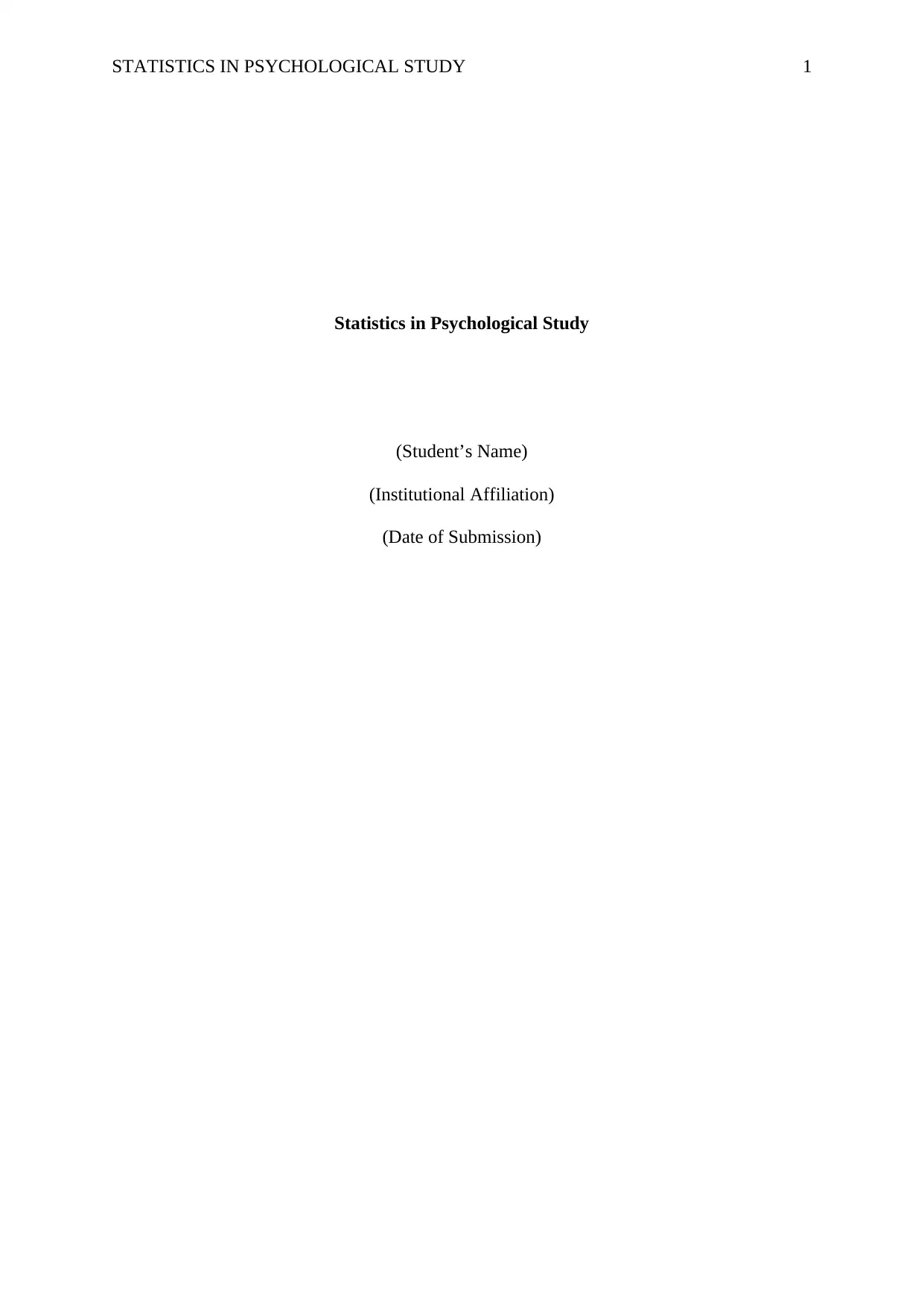
STATISTICS IN PSYCHOLOGICAL STUDY 1
Statistics in Psychological Study
(Student’s Name)
(Institutional Affiliation)
(Date of Submission)
Statistics in Psychological Study
(Student’s Name)
(Institutional Affiliation)
(Date of Submission)
Paraphrase This Document
Need a fresh take? Get an instant paraphrase of this document with our AI Paraphraser
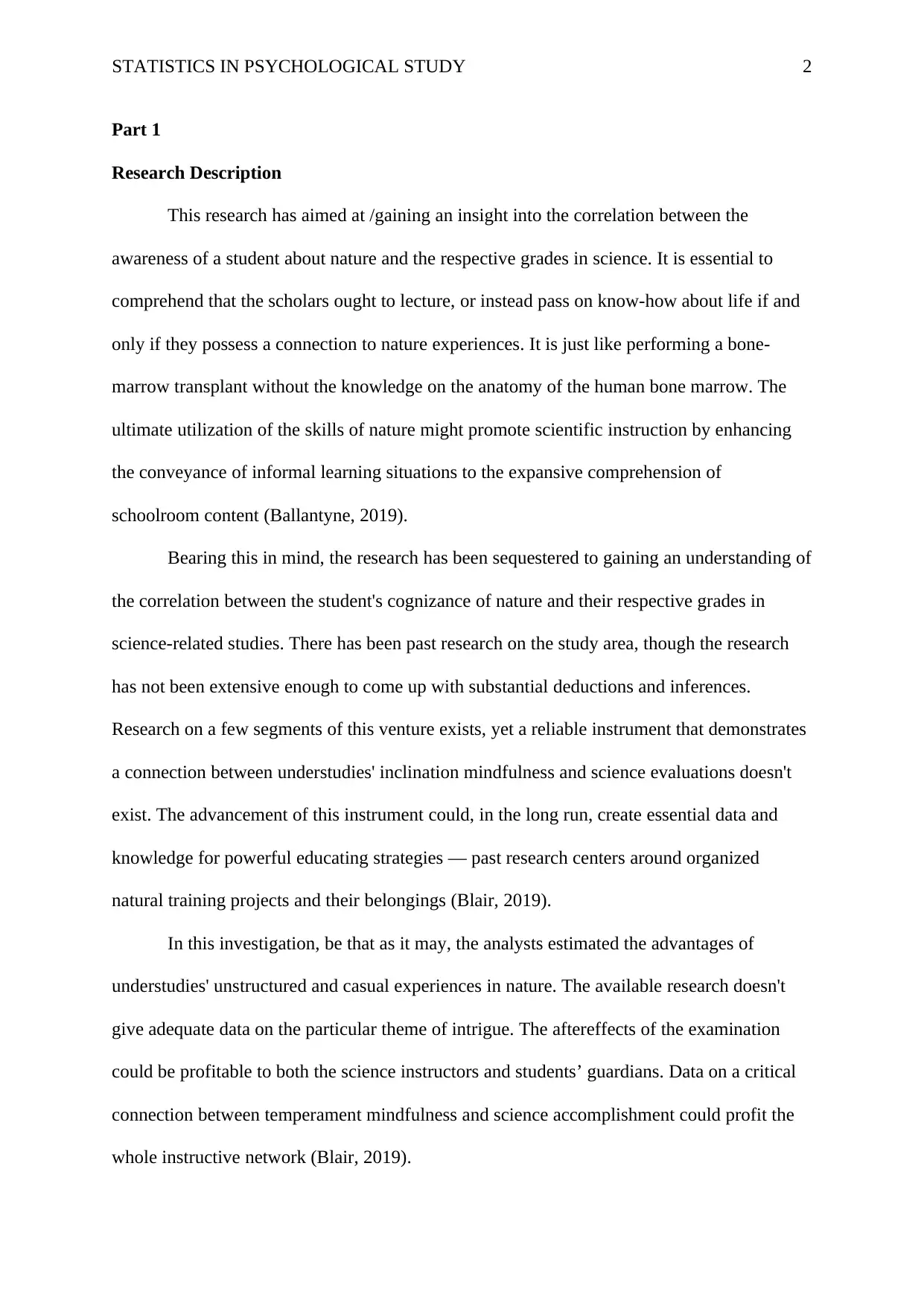
STATISTICS IN PSYCHOLOGICAL STUDY 2
Part 1
Research Description
This research has aimed at /gaining an insight into the correlation between the
awareness of a student about nature and the respective grades in science. It is essential to
comprehend that the scholars ought to lecture, or instead pass on know-how about life if and
only if they possess a connection to nature experiences. It is just like performing a bone-
marrow transplant without the knowledge on the anatomy of the human bone marrow. The
ultimate utilization of the skills of nature might promote scientific instruction by enhancing
the conveyance of informal learning situations to the expansive comprehension of
schoolroom content (Ballantyne, 2019).
Bearing this in mind, the research has been sequestered to gaining an understanding of
the correlation between the student's cognizance of nature and their respective grades in
science-related studies. There has been past research on the study area, though the research
has not been extensive enough to come up with substantial deductions and inferences.
Research on a few segments of this venture exists, yet a reliable instrument that demonstrates
a connection between understudies' inclination mindfulness and science evaluations doesn't
exist. The advancement of this instrument could, in the long run, create essential data and
knowledge for powerful educating strategies — past research centers around organized
natural training projects and their belongings (Blair, 2019).
In this investigation, be that as it may, the analysts estimated the advantages of
understudies' unstructured and casual experiences in nature. The available research doesn't
give adequate data on the particular theme of intrigue. The aftereffects of the examination
could be profitable to both the science instructors and students’ guardians. Data on a critical
connection between temperament mindfulness and science accomplishment could profit the
whole instructive network (Blair, 2019).
Part 1
Research Description
This research has aimed at /gaining an insight into the correlation between the
awareness of a student about nature and the respective grades in science. It is essential to
comprehend that the scholars ought to lecture, or instead pass on know-how about life if and
only if they possess a connection to nature experiences. It is just like performing a bone-
marrow transplant without the knowledge on the anatomy of the human bone marrow. The
ultimate utilization of the skills of nature might promote scientific instruction by enhancing
the conveyance of informal learning situations to the expansive comprehension of
schoolroom content (Ballantyne, 2019).
Bearing this in mind, the research has been sequestered to gaining an understanding of
the correlation between the student's cognizance of nature and their respective grades in
science-related studies. There has been past research on the study area, though the research
has not been extensive enough to come up with substantial deductions and inferences.
Research on a few segments of this venture exists, yet a reliable instrument that demonstrates
a connection between understudies' inclination mindfulness and science evaluations doesn't
exist. The advancement of this instrument could, in the long run, create essential data and
knowledge for powerful educating strategies — past research centers around organized
natural training projects and their belongings (Blair, 2019).
In this investigation, be that as it may, the analysts estimated the advantages of
understudies' unstructured and casual experiences in nature. The available research doesn't
give adequate data on the particular theme of intrigue. The aftereffects of the examination
could be profitable to both the science instructors and students’ guardians. Data on a critical
connection between temperament mindfulness and science accomplishment could profit the
whole instructive network (Blair, 2019).
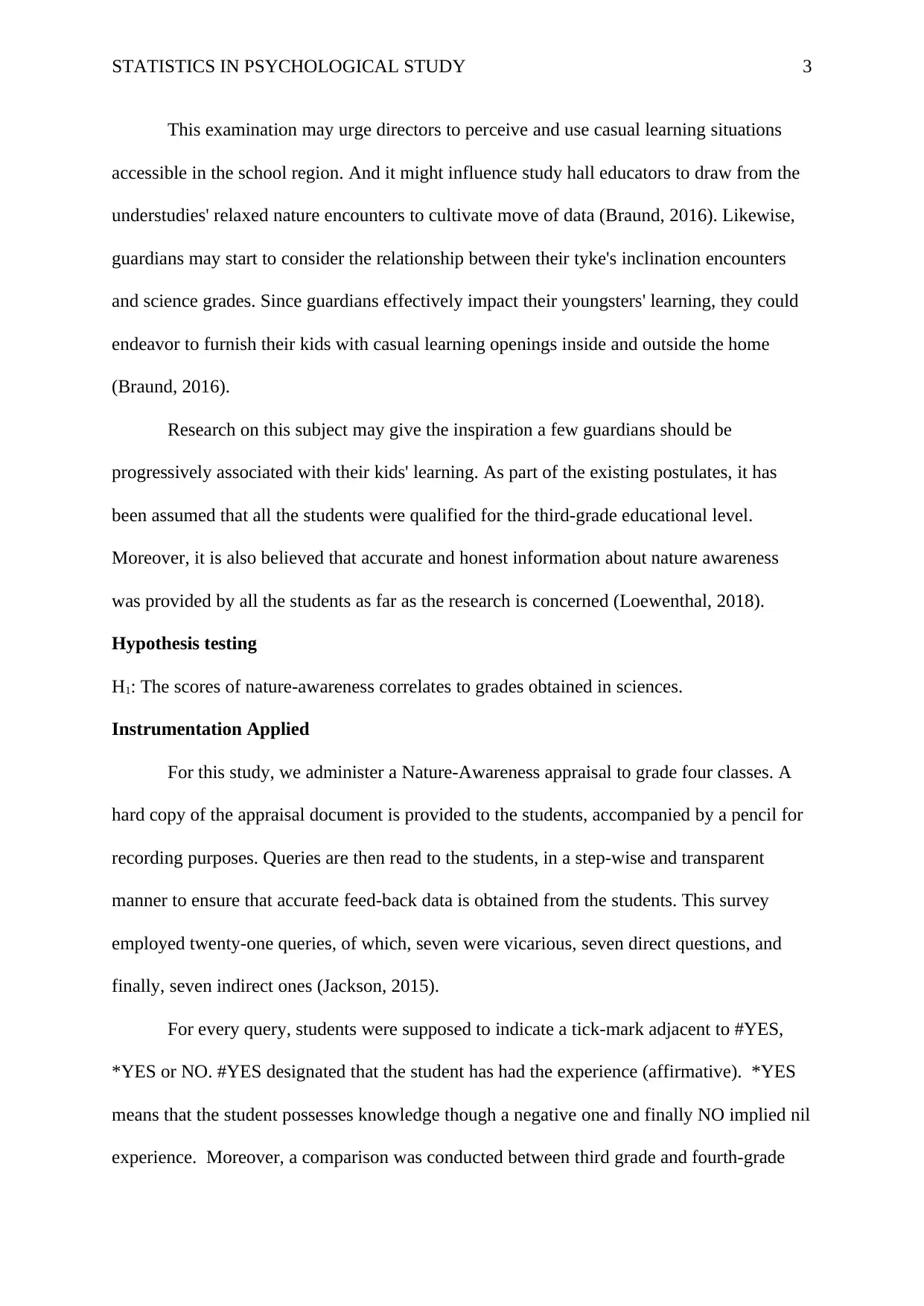
STATISTICS IN PSYCHOLOGICAL STUDY 3
This examination may urge directors to perceive and use casual learning situations
accessible in the school region. And it might influence study hall educators to draw from the
understudies' relaxed nature encounters to cultivate move of data (Braund, 2016). Likewise,
guardians may start to consider the relationship between their tyke's inclination encounters
and science grades. Since guardians effectively impact their youngsters' learning, they could
endeavor to furnish their kids with casual learning openings inside and outside the home
(Braund, 2016).
Research on this subject may give the inspiration a few guardians should be
progressively associated with their kids' learning. As part of the existing postulates, it has
been assumed that all the students were qualified for the third-grade educational level.
Moreover, it is also believed that accurate and honest information about nature awareness
was provided by all the students as far as the research is concerned (Loewenthal, 2018).
Hypothesis testing
H1: The scores of nature-awareness correlates to grades obtained in sciences.
Instrumentation Applied
For this study, we administer a Nature-Awareness appraisal to grade four classes. A
hard copy of the appraisal document is provided to the students, accompanied by a pencil for
recording purposes. Queries are then read to the students, in a step-wise and transparent
manner to ensure that accurate feed-back data is obtained from the students. This survey
employed twenty-one queries, of which, seven were vicarious, seven direct questions, and
finally, seven indirect ones (Jackson, 2015).
For every query, students were supposed to indicate a tick-mark adjacent to #YES,
*YES or NO. #YES designated that the student has had the experience (affirmative). *YES
means that the student possesses knowledge though a negative one and finally NO implied nil
experience. Moreover, a comparison was conducted between third grade and fourth-grade
This examination may urge directors to perceive and use casual learning situations
accessible in the school region. And it might influence study hall educators to draw from the
understudies' relaxed nature encounters to cultivate move of data (Braund, 2016). Likewise,
guardians may start to consider the relationship between their tyke's inclination encounters
and science grades. Since guardians effectively impact their youngsters' learning, they could
endeavor to furnish their kids with casual learning openings inside and outside the home
(Braund, 2016).
Research on this subject may give the inspiration a few guardians should be
progressively associated with their kids' learning. As part of the existing postulates, it has
been assumed that all the students were qualified for the third-grade educational level.
Moreover, it is also believed that accurate and honest information about nature awareness
was provided by all the students as far as the research is concerned (Loewenthal, 2018).
Hypothesis testing
H1: The scores of nature-awareness correlates to grades obtained in sciences.
Instrumentation Applied
For this study, we administer a Nature-Awareness appraisal to grade four classes. A
hard copy of the appraisal document is provided to the students, accompanied by a pencil for
recording purposes. Queries are then read to the students, in a step-wise and transparent
manner to ensure that accurate feed-back data is obtained from the students. This survey
employed twenty-one queries, of which, seven were vicarious, seven direct questions, and
finally, seven indirect ones (Jackson, 2015).
For every query, students were supposed to indicate a tick-mark adjacent to #YES,
*YES or NO. #YES designated that the student has had the experience (affirmative). *YES
means that the student possesses knowledge though a negative one and finally NO implied nil
experience. Moreover, a comparison was conducted between third grade and fourth-grade
⊘ This is a preview!⊘
Do you want full access?
Subscribe today to unlock all pages.

Trusted by 1+ million students worldwide
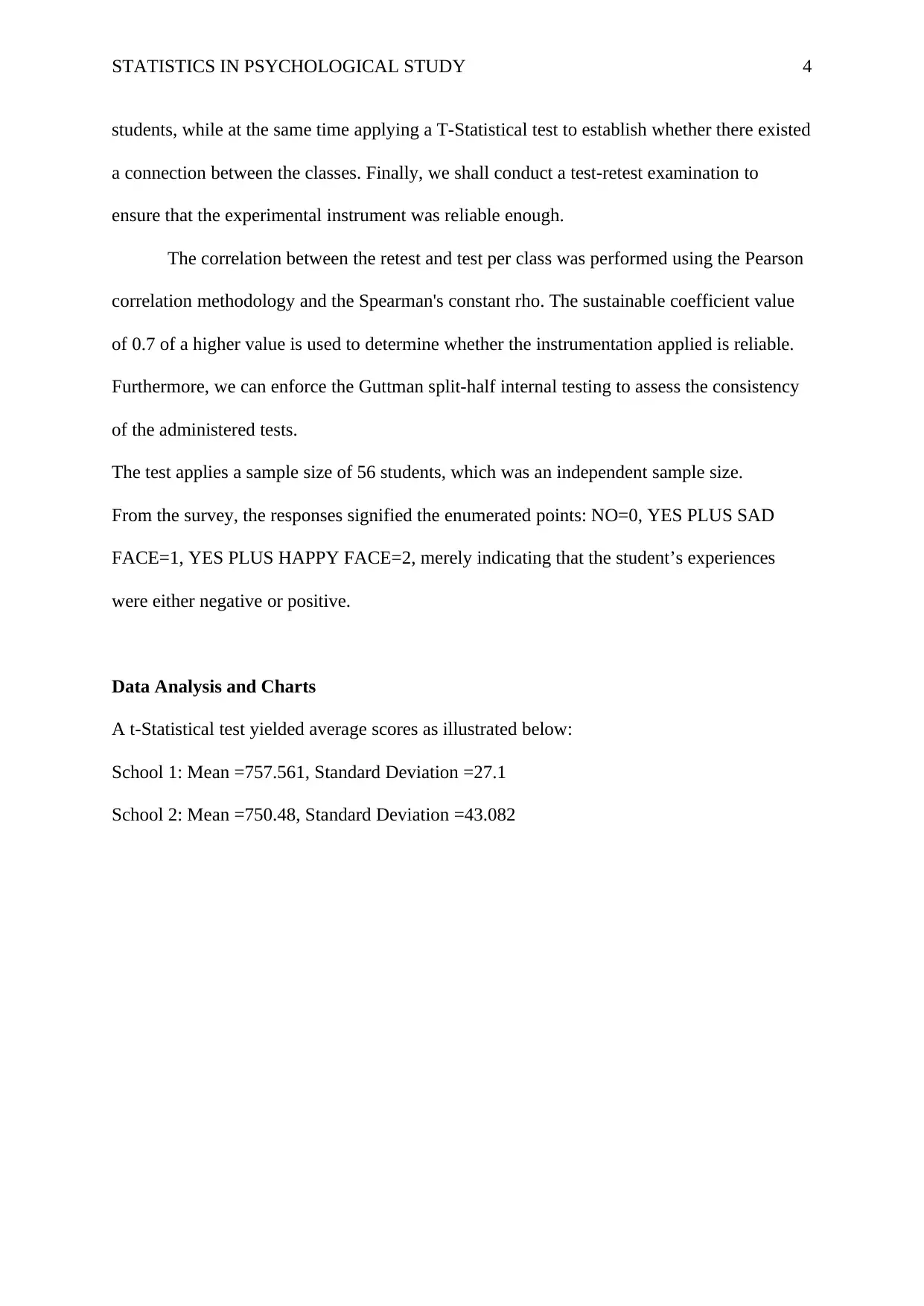
STATISTICS IN PSYCHOLOGICAL STUDY 4
students, while at the same time applying a T-Statistical test to establish whether there existed
a connection between the classes. Finally, we shall conduct a test-retest examination to
ensure that the experimental instrument was reliable enough.
The correlation between the retest and test per class was performed using the Pearson
correlation methodology and the Spearman's constant rho. The sustainable coefficient value
of 0.7 of a higher value is used to determine whether the instrumentation applied is reliable.
Furthermore, we can enforce the Guttman split-half internal testing to assess the consistency
of the administered tests.
The test applies a sample size of 56 students, which was an independent sample size.
From the survey, the responses signified the enumerated points: NO=0, YES PLUS SAD
FACE=1, YES PLUS HAPPY FACE=2, merely indicating that the student’s experiences
were either negative or positive.
Data Analysis and Charts
A t-Statistical test yielded average scores as illustrated below:
School 1: Mean =757.561, Standard Deviation =27.1
School 2: Mean =750.48, Standard Deviation =43.082
students, while at the same time applying a T-Statistical test to establish whether there existed
a connection between the classes. Finally, we shall conduct a test-retest examination to
ensure that the experimental instrument was reliable enough.
The correlation between the retest and test per class was performed using the Pearson
correlation methodology and the Spearman's constant rho. The sustainable coefficient value
of 0.7 of a higher value is used to determine whether the instrumentation applied is reliable.
Furthermore, we can enforce the Guttman split-half internal testing to assess the consistency
of the administered tests.
The test applies a sample size of 56 students, which was an independent sample size.
From the survey, the responses signified the enumerated points: NO=0, YES PLUS SAD
FACE=1, YES PLUS HAPPY FACE=2, merely indicating that the student’s experiences
were either negative or positive.
Data Analysis and Charts
A t-Statistical test yielded average scores as illustrated below:
School 1: Mean =757.561, Standard Deviation =27.1
School 2: Mean =750.48, Standard Deviation =43.082
Paraphrase This Document
Need a fresh take? Get an instant paraphrase of this document with our AI Paraphraser
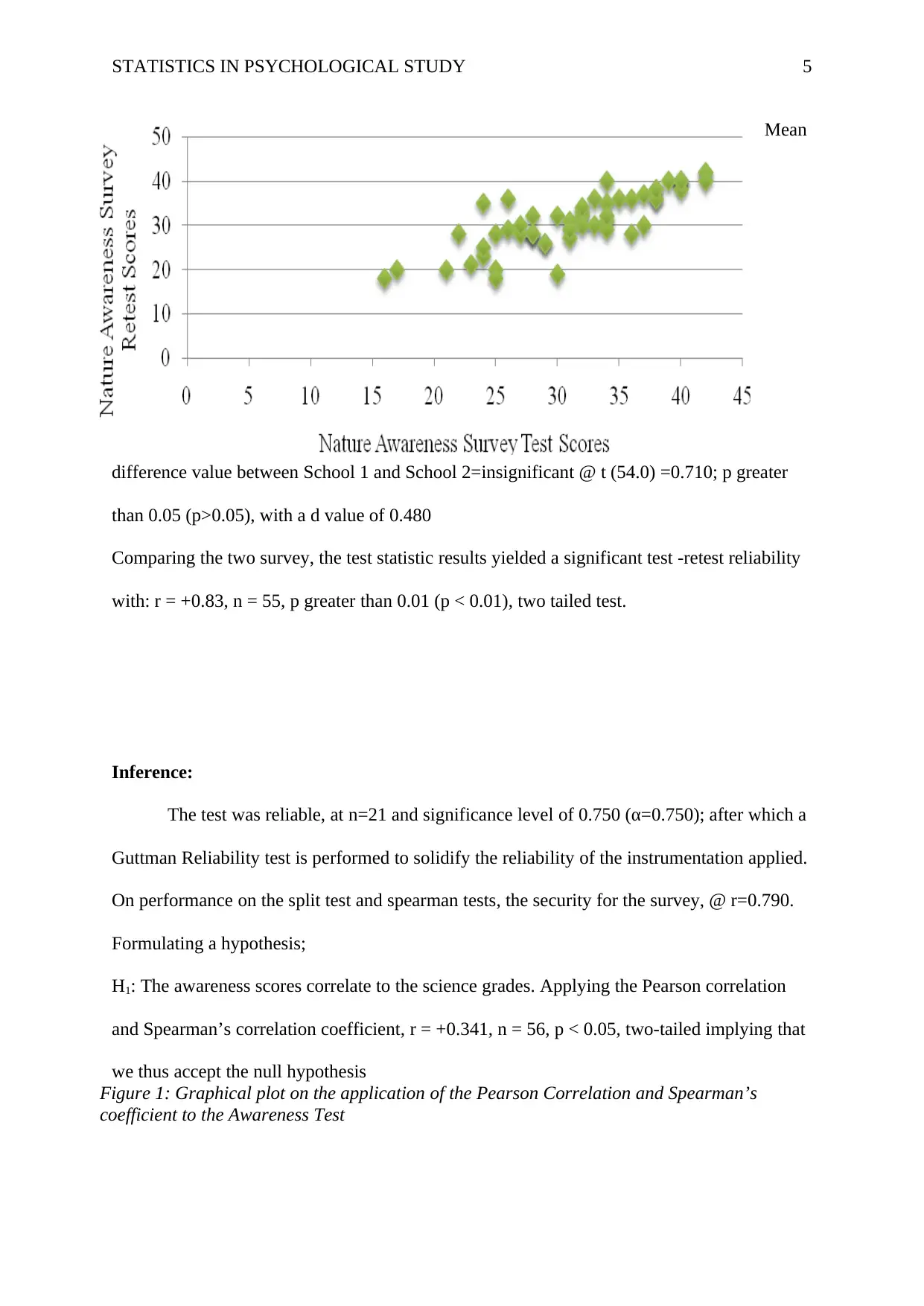
STATISTICS IN PSYCHOLOGICAL STUDY 5
Mean
difference value between School 1 and School 2=insignificant @ t (54.0) =0.710; p greater
than 0.05 (p>0.05), with a d value of 0.480
Comparing the two survey, the test statistic results yielded a significant test -retest reliability
with: r = +0.83, n = 55, p greater than 0.01 (p < 0.01), two tailed test.
Inference:
The test was reliable, at n=21 and significance level of 0.750 (α=0.750); after which a
Guttman Reliability test is performed to solidify the reliability of the instrumentation applied.
On performance on the split test and spearman tests, the security for the survey, @ r=0.790.
Formulating a hypothesis;
H1: The awareness scores correlate to the science grades. Applying the Pearson correlation
and Spearman’s correlation coefficient, r = +0.341, n = 56, p < 0.05, two-tailed implying that
we thus accept the null hypothesis
Figure 1: Graphical plot on the application of the Pearson Correlation and Spearman’s
coefficient to the Awareness Test
Mean
difference value between School 1 and School 2=insignificant @ t (54.0) =0.710; p greater
than 0.05 (p>0.05), with a d value of 0.480
Comparing the two survey, the test statistic results yielded a significant test -retest reliability
with: r = +0.83, n = 55, p greater than 0.01 (p < 0.01), two tailed test.
Inference:
The test was reliable, at n=21 and significance level of 0.750 (α=0.750); after which a
Guttman Reliability test is performed to solidify the reliability of the instrumentation applied.
On performance on the split test and spearman tests, the security for the survey, @ r=0.790.
Formulating a hypothesis;
H1: The awareness scores correlate to the science grades. Applying the Pearson correlation
and Spearman’s correlation coefficient, r = +0.341, n = 56, p < 0.05, two-tailed implying that
we thus accept the null hypothesis
Figure 1: Graphical plot on the application of the Pearson Correlation and Spearman’s
coefficient to the Awareness Test
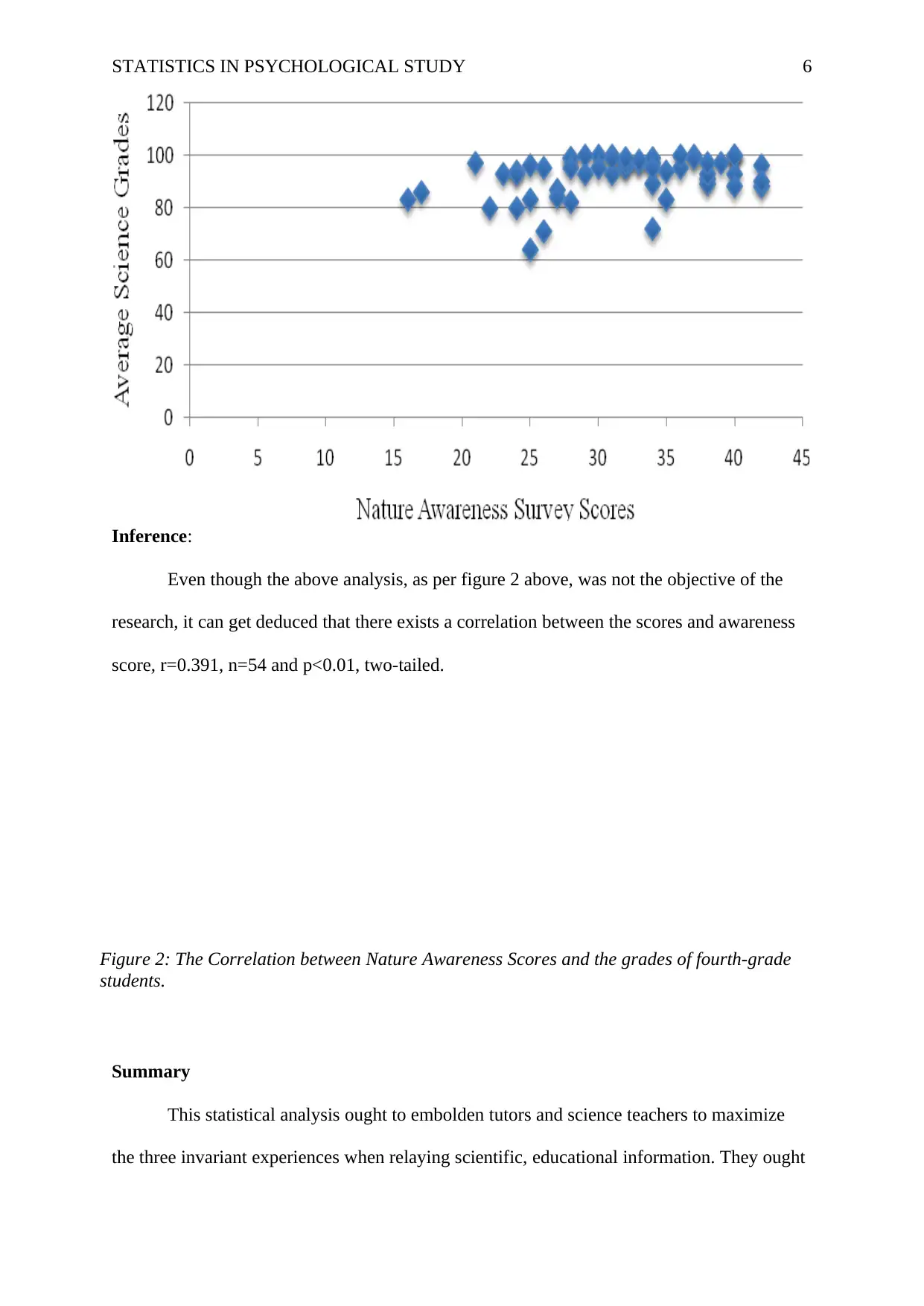
STATISTICS IN PSYCHOLOGICAL STUDY 6
Inference:
Even though the above analysis, as per figure 2 above, was not the objective of the
research, it can get deduced that there exists a correlation between the scores and awareness
score, r=0.391, n=54 and p<0.01, two-tailed.
Summary
This statistical analysis ought to embolden tutors and science teachers to maximize
the three invariant experiences when relaying scientific, educational information. They ought
Figure 2: The Correlation between Nature Awareness Scores and the grades of fourth-grade
students.
Inference:
Even though the above analysis, as per figure 2 above, was not the objective of the
research, it can get deduced that there exists a correlation between the scores and awareness
score, r=0.391, n=54 and p<0.01, two-tailed.
Summary
This statistical analysis ought to embolden tutors and science teachers to maximize
the three invariant experiences when relaying scientific, educational information. They ought
Figure 2: The Correlation between Nature Awareness Scores and the grades of fourth-grade
students.
⊘ This is a preview!⊘
Do you want full access?
Subscribe today to unlock all pages.

Trusted by 1+ million students worldwide
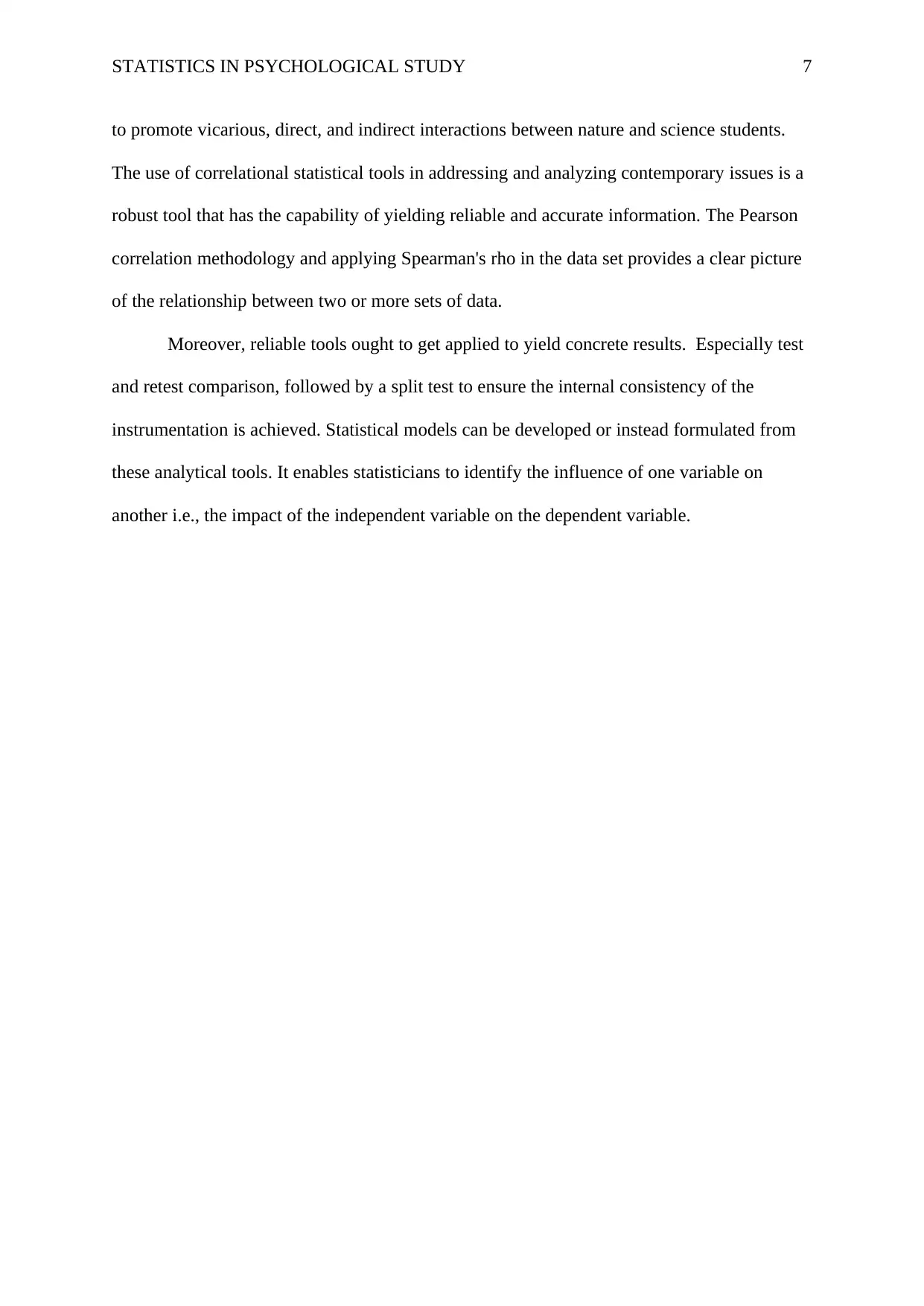
STATISTICS IN PSYCHOLOGICAL STUDY 7
to promote vicarious, direct, and indirect interactions between nature and science students.
The use of correlational statistical tools in addressing and analyzing contemporary issues is a
robust tool that has the capability of yielding reliable and accurate information. The Pearson
correlation methodology and applying Spearman's rho in the data set provides a clear picture
of the relationship between two or more sets of data.
Moreover, reliable tools ought to get applied to yield concrete results. Especially test
and retest comparison, followed by a split test to ensure the internal consistency of the
instrumentation is achieved. Statistical models can be developed or instead formulated from
these analytical tools. It enables statisticians to identify the influence of one variable on
another i.e., the impact of the independent variable on the dependent variable.
to promote vicarious, direct, and indirect interactions between nature and science students.
The use of correlational statistical tools in addressing and analyzing contemporary issues is a
robust tool that has the capability of yielding reliable and accurate information. The Pearson
correlation methodology and applying Spearman's rho in the data set provides a clear picture
of the relationship between two or more sets of data.
Moreover, reliable tools ought to get applied to yield concrete results. Especially test
and retest comparison, followed by a split test to ensure the internal consistency of the
instrumentation is achieved. Statistical models can be developed or instead formulated from
these analytical tools. It enables statisticians to identify the influence of one variable on
another i.e., the impact of the independent variable on the dependent variable.
Paraphrase This Document
Need a fresh take? Get an instant paraphrase of this document with our AI Paraphraser
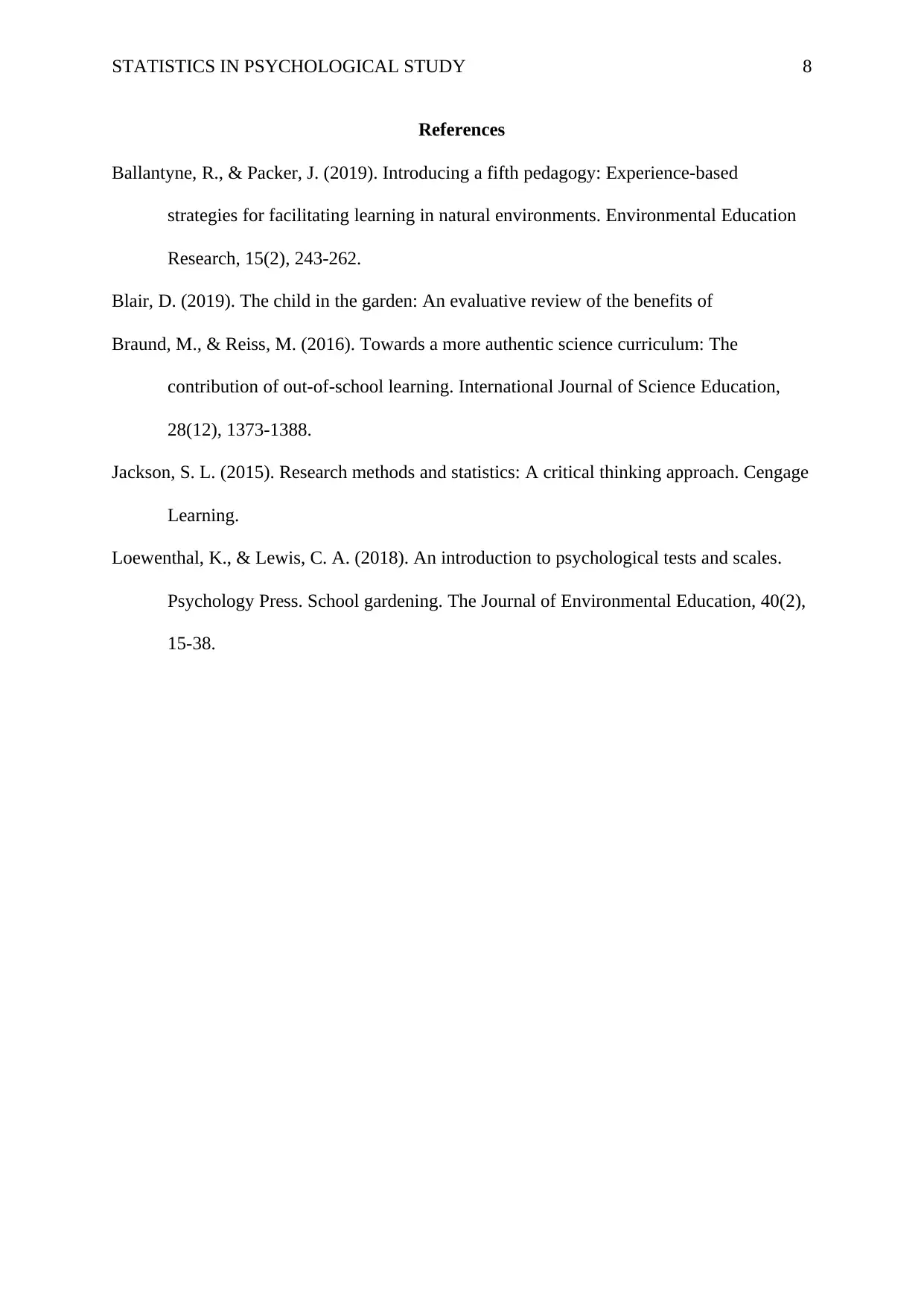
STATISTICS IN PSYCHOLOGICAL STUDY 8
References
Ballantyne, R., & Packer, J. (2019). Introducing a fifth pedagogy: Experience-based
strategies for facilitating learning in natural environments. Environmental Education
Research, 15(2), 243-262.
Blair, D. (2019). The child in the garden: An evaluative review of the benefits of
Braund, M., & Reiss, M. (2016). Towards a more authentic science curriculum: The
contribution of out-of-school learning. International Journal of Science Education,
28(12), 1373-1388.
Jackson, S. L. (2015). Research methods and statistics: A critical thinking approach. Cengage
Learning.
Loewenthal, K., & Lewis, C. A. (2018). An introduction to psychological tests and scales.
Psychology Press. School gardening. The Journal of Environmental Education, 40(2),
15-38.
References
Ballantyne, R., & Packer, J. (2019). Introducing a fifth pedagogy: Experience-based
strategies for facilitating learning in natural environments. Environmental Education
Research, 15(2), 243-262.
Blair, D. (2019). The child in the garden: An evaluative review of the benefits of
Braund, M., & Reiss, M. (2016). Towards a more authentic science curriculum: The
contribution of out-of-school learning. International Journal of Science Education,
28(12), 1373-1388.
Jackson, S. L. (2015). Research methods and statistics: A critical thinking approach. Cengage
Learning.
Loewenthal, K., & Lewis, C. A. (2018). An introduction to psychological tests and scales.
Psychology Press. School gardening. The Journal of Environmental Education, 40(2),
15-38.
1 out of 8
Your All-in-One AI-Powered Toolkit for Academic Success.
+13062052269
info@desklib.com
Available 24*7 on WhatsApp / Email
![[object Object]](/_next/static/media/star-bottom.7253800d.svg)
Unlock your academic potential
Copyright © 2020–2025 A2Z Services. All Rights Reserved. Developed and managed by ZUCOL.